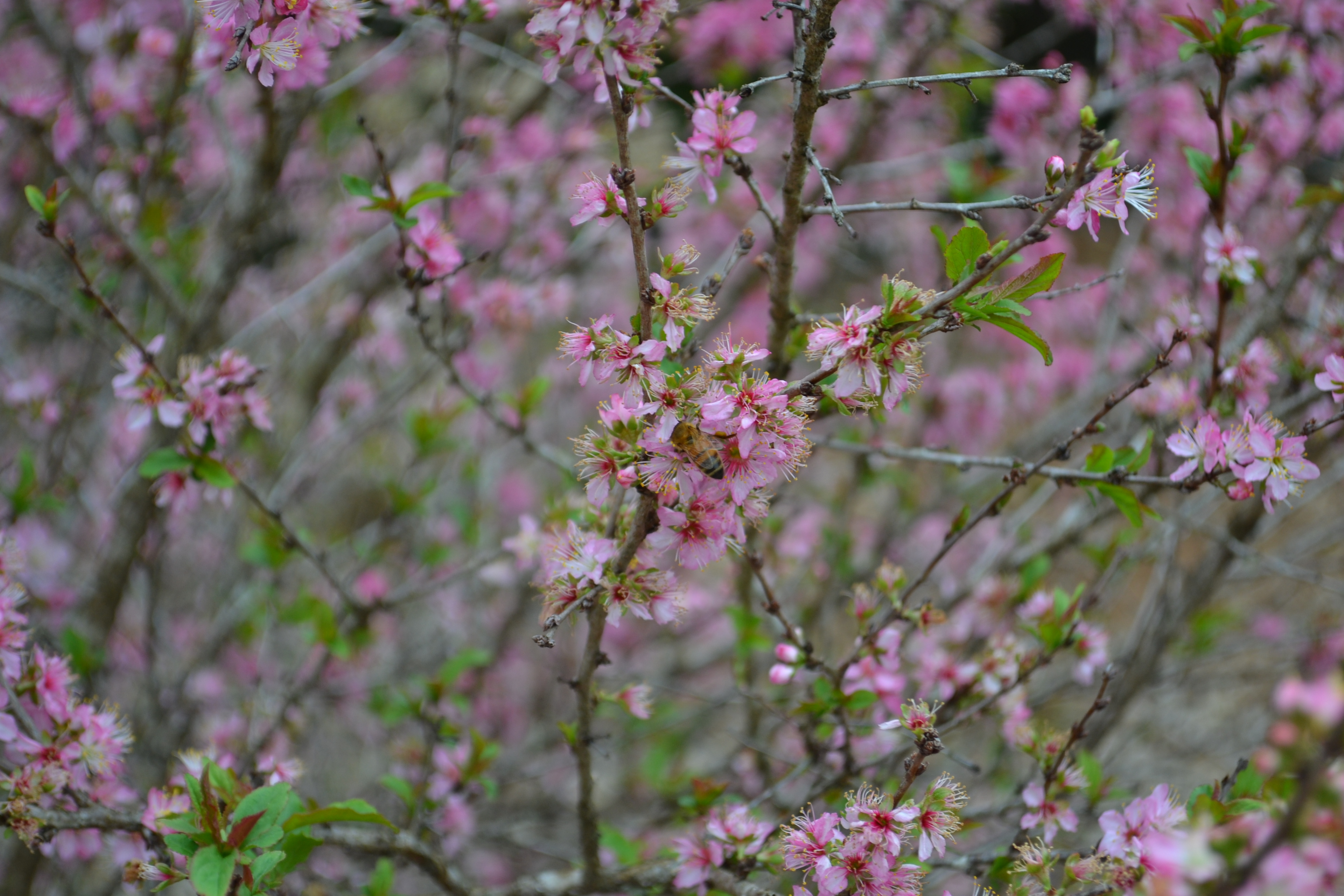
by Beth Bolles | Mar 10, 2015
Although we are not able to grow edible cherry trees in more southern climates, there are a few ornamental relatives of the cherry that are worth adding to the landscape. The Bush cherry, Prunus jacquemontii, is an attractive deciduous shrub that is a highlight with pink blooms in late winter. Flowers provide an early nectar source to bees.
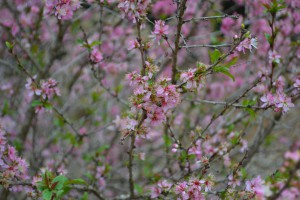
Bees are actively visiting flowers.
Plant the bush cherry is an area that receives sunlight and allows for the rounded shrub to grow about 5 feet by 5 feet. Plants like well-drained soil but benefit from some moisture during the growing season. Small berries serve as a food source for wildlife and can be used in jellies and jams. Leaves turn yellow in the fall before dropping. Plants are generally low maintenance and certainly brighten winter days. 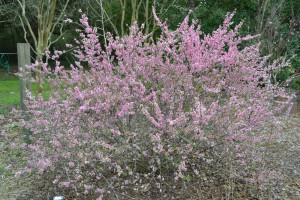
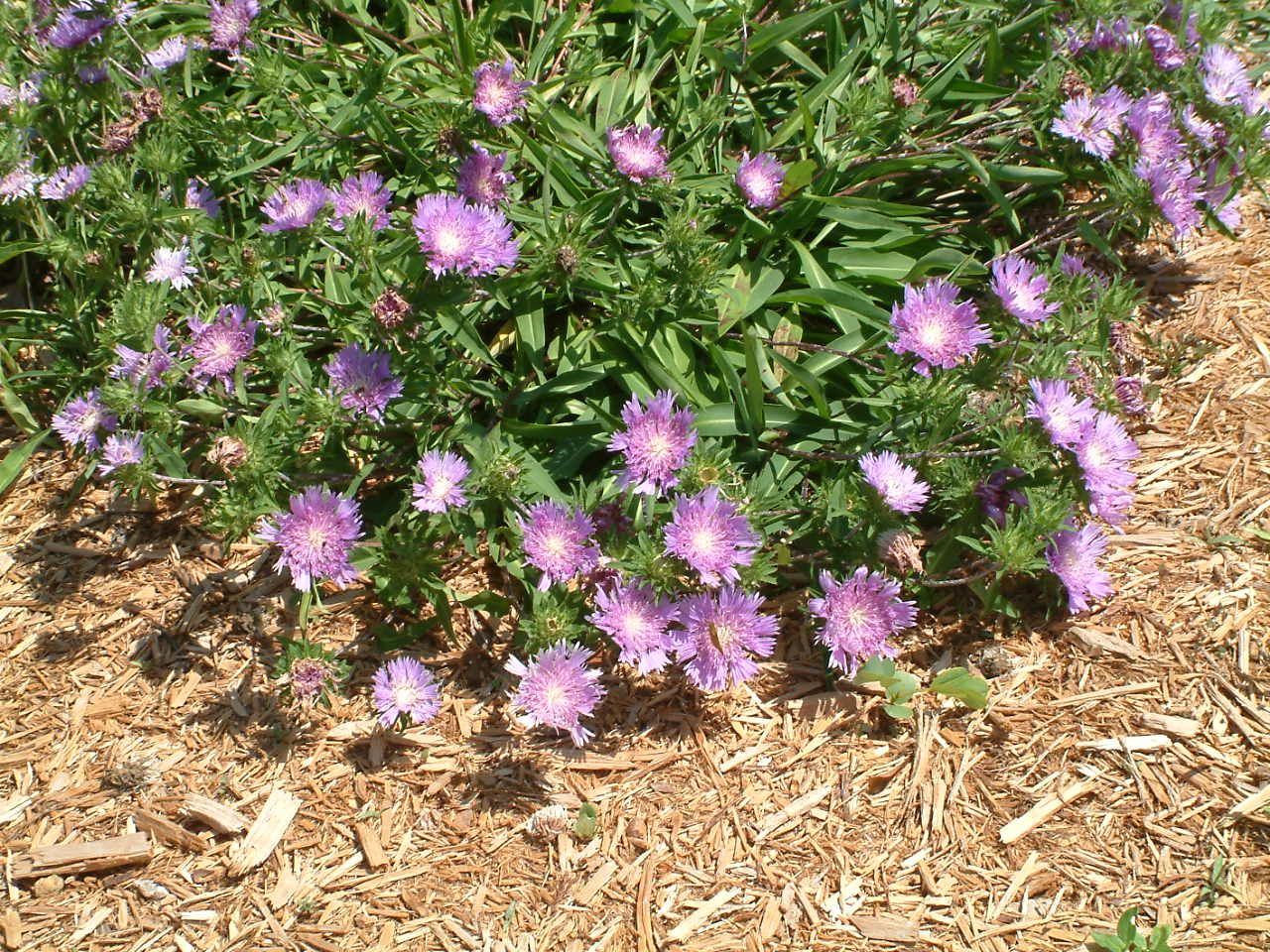
by Beth Bolles | Feb 10, 2015
Variety is the spice of life and more homeowners are incorporating this philosophy into the design of their homes. Windows especially are becoming more of a design feature, so we should change our philosophy on landscaping around them.
Windows allow us to feel connected to the outdoors and allow natural light to pass into the living area. They let us enjoy flowers, wildlife, and even keep an eye on outdoor activities. Because so many homes are using larger frame windows that may be only two feet off the ground, careful planning of landscaping is necessary so views are not blocked by a mass of branches and leaves.
Many common foundation plants that have been planted around homes in the past may not be good choices for homes with low windows. Ligustrum, various holly and loropetalum species, and several types of azaleas will mature to medium‑sized shrubs and block a good portion of windows in a couple of years. Though continuous pruning can keep these plants low, it also can result in pest problems due to frequent pruning wounds and thick growth.
Foundation plants should create a low‑maintenance landscape. Selecting plants that do not grow into the view of windows will save time and money in unnecessary maintenance activities.
Nurseries carry a wide variety of interesting plants. There are dwarf varieties of evergreen shrubs, such as ‘Prostrata’ Japanese plum yew, ‘Purple Pixie’ loropetalum, and many new dwarf nandinas that can be planted in front of some windows.
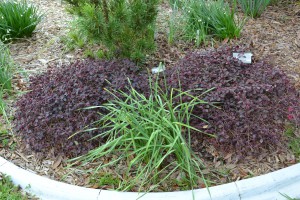
‘Purple Pixie’ loropetalum.
Groundcovers, or even flowering annuals and perennials, could also be good choices under windows. These plants can break the monotony of a typical foundation planting.
Maintaining a mass of annual or perennial flowers below front windows will require a little more work throughout the year. The flower planting will have to be weeded, groomed and even replaced from time to time. A separate irrigation zone for the flowering plants will need to be established so that other foundation shrubs do not receive too much water when the annuals and perennials are watered.
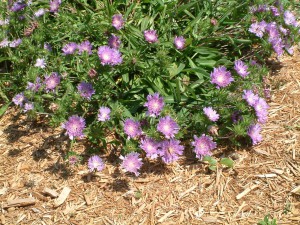
Stoke’s aster is an evergreen groundcover for sunny areas.
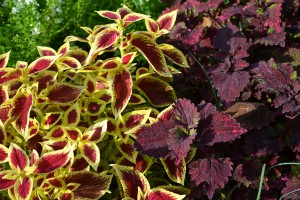
The are almost endless selections of beautiful sun coleus.
In full sun, consider Stoke’s aster, sun coleus, Dicliptera, daylilies, sedum, or Oxeye daisy, In shade, consider caladiums, ferns and ‘Hip Hop’ Euphorbia.
There are many groundcovers that can be used. Know the growth habit of the particular groundcover since many such as Asiatic jasmine and junipers will spread over large areas. Consider clumping plants like muhly grass or ‘Evergreen Giant’ liriope.
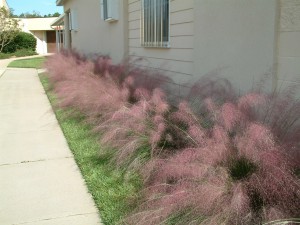
Mulhly grass shows off purplish blooms in the late summer and fall.
Plants aren’t the only possibility for areas around windows. Consider garden ornaments, or create a bird window, with a bird bath, feeder or ground‑feeding area for animals that can be viewed from indoors.
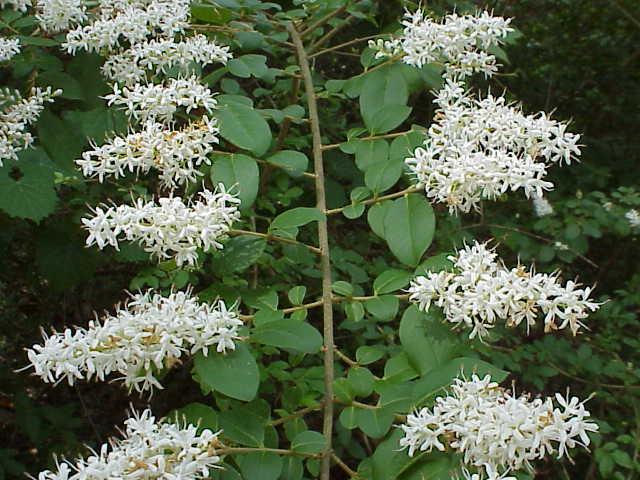
by Beth Bolles | Jan 13, 2015
The Chinese privet, Ligustrum sinense, is a plant that is well known to many people as a great nuisance in the landscape. It is also a Florida noxious weed because of its invasive nature.
Originally grown as an ornamental that formed a hedge and tolerated poor conditions, the Chinese privet has now spread to natural areas and grows easily on disturbed soils. Plants are full of white fragrant flowers in the spring with abundant small black fruit forming late summer and remaining into the winter. Seeds are easily spread by wildlife to new areas but new plants can also grow from roots.
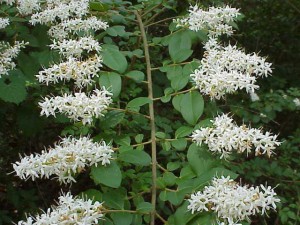
Privet may be best identified when it is in bloom.
Chinese privet easily forms a thicket, shading areas and impacting the growth of native plants. Homeowners can identify any plants growing on their property and work to manage Chinese privet when plants are not in seed. If you need assistance in identification, contact your local Extension office or view pictures online.
Even though homeowners will not find Ligustrum sinense in the nursery, cultivars of this plant may be found. One newer selection is ‘Sunshine’. This is a reportedly sterile cultivar that grows much smaller and has yellow foliage. Homeowners who choose to install ‘Sunshine’ may still need to be cautious since there has not been extensive research in Florida to verify that it will not become a future issue.
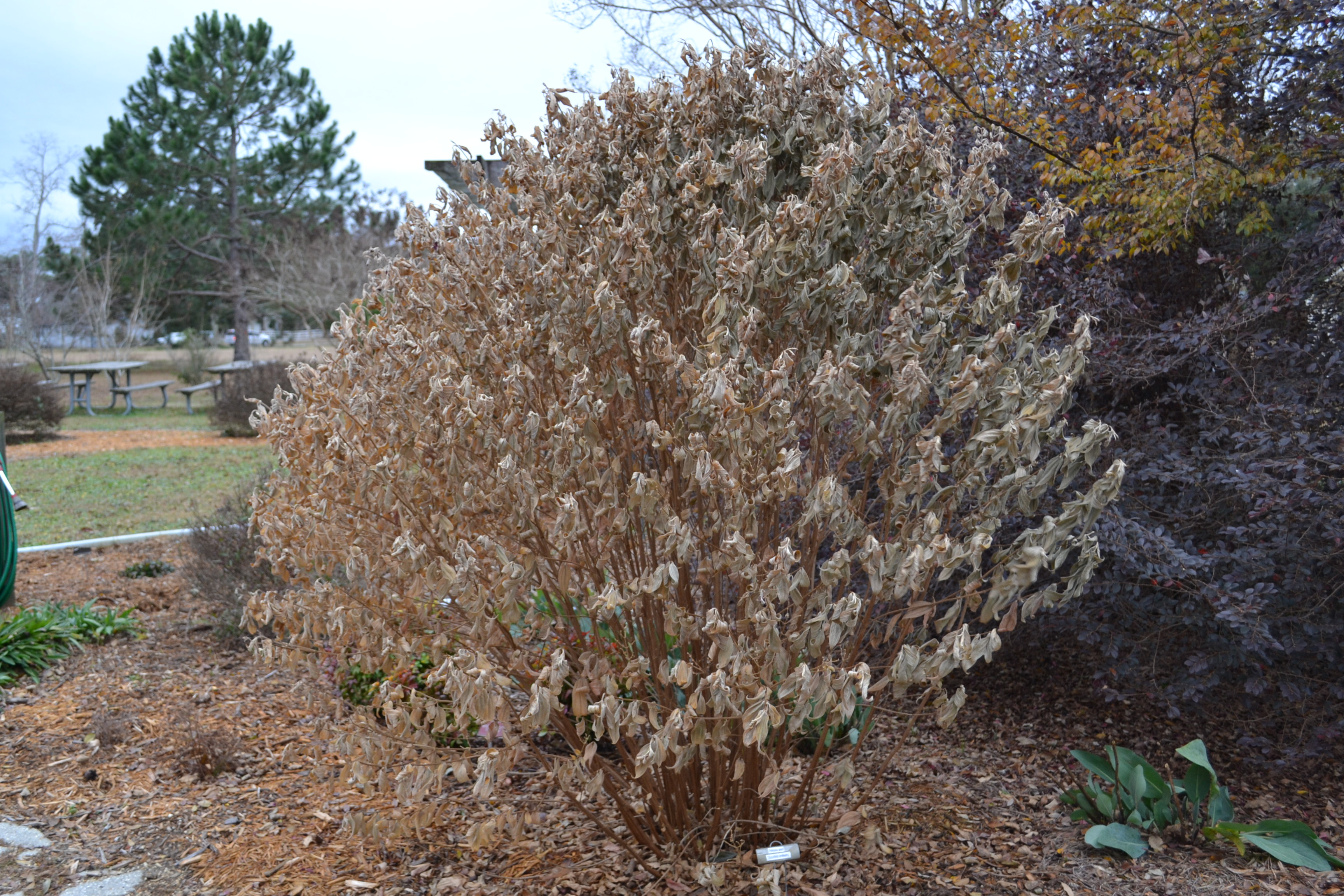
by Beth Bolles | Dec 2, 2014
Our recent cold weather was not only a surprise for many locals but also for many plants that still had plenty of green growth. After a couple of nights of freezing temperatures, even deciduous trees that had not dropped their leaves, look a little ratty.
Since it is just the beginning of December and we are likely to have many more days this winter with cold weather, now is not the time to react to plants that were damaged. There are a few exceptions of plants that you can prune back, but in general patience is the key for the winter garden and cold-damaged plants.
Here are a few guidelines.
Unless planted in very protected spots, annuals like coleus and angelonia were killed by recent cold air. You may remove these plants or cut them back close to the group to make garden areas look neater. You may want to add some new winter annuals to brighten up these spots.

Warm season annuals can be removed from the garden.
Both young and mature citrus trees experienced injury since many plants still had tender growth. Do not prune out any damage at this time. We will wait until next Spring to learn where the growth will resume and then prune as necessary to remove dead branches.
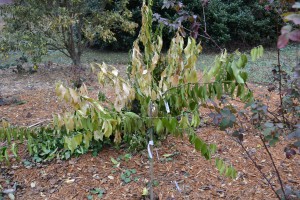
The tender growth on a young Meyer lemon was damaged by cold air.
As expected, the above ground portions of flowering perennials were severely injured by cold air. It is best not to prune these back now since the layer of branches and foliage may help insulate lower branches that could still have some life. If you are not able to tolerate the look of cold-damaged perennials in your garden, consider only pruning half of the plant just to make a neater appearance in the garden. When warm weather returns next year, we may be surprised to see growth resume on lower stems.
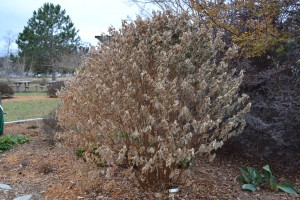
Many flowering perennials like Tibouchina will return from the ground next year.
Deciduous trees that would have normally dropped leaves before the cold have full canopies of dead leaves. Trees will eventually drop these leaves aided by winter winds and rainfall.
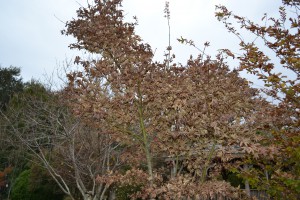
This Japanese maple will eventually drop it’s cold-damaged leaves and offer attractive bark and structure in the winter garden.
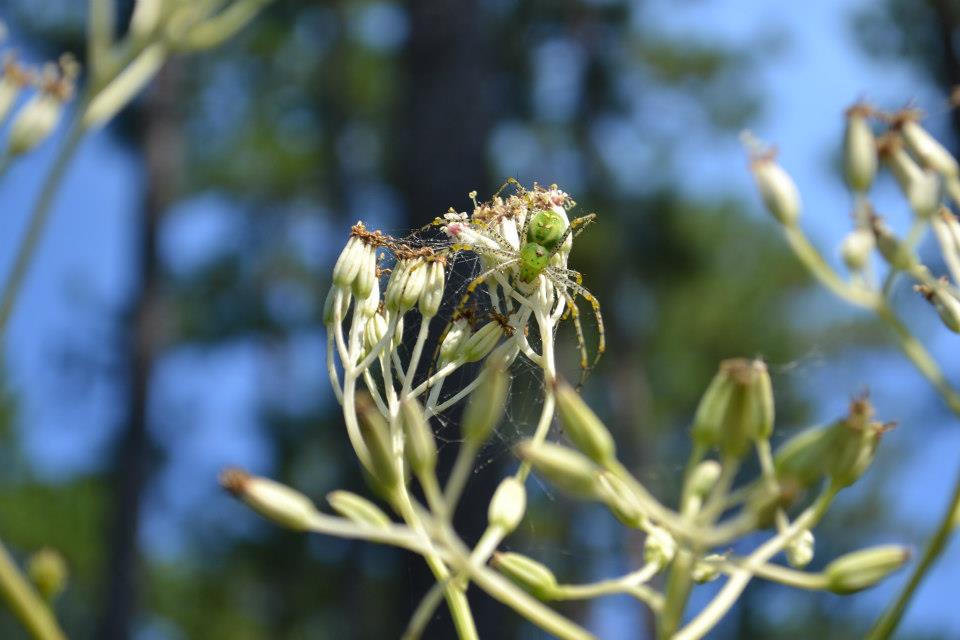
by Beth Bolles | Nov 4, 2014
Take a walk through the garden or woods this fall and you are sure to pass by a Green lynx spider. Unless you are very observant though, you will probably not realize that this common spider is perched upon flowers and low shrubs, ready to catch an insect meal.

An adult spider blends in well with plants. Photo by Beth Bolles, Escambia County Extension
Even though Green lynx spiders are very large, they are often well camouflaged in plant material. Spiders are bright green with a lighter color on the abdomen including some small red markings. The legs have distinctive black spines.
This spider does not spin a web but actively hunts insects using a dragline as it quickly moves or jumps over plants. It is an opportunistic feeder catching many types of insects that are visiting flowers. It has been noted as an important predator of some crop damaging insects.
Females will normally lay one egg sac in the fall and guard it from predators. It is constructed in the upper portions of branches and has webbing connecting it to nearby plant leaves. This webbing becomes a protective area for the emerged spiderlings until they are able to take care of themselves.
Lynx spiders pose no harm to people and should be considered one of many beneficial arthropods that we see in Florida.
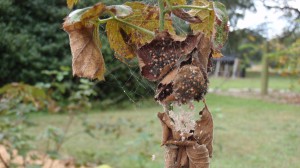
Young spiderlings on a blackberry guarded by the adult. Photo by Beth Bolles, Escambia Extension


















